#its not involved in AI development and there is no impact against others when its used. stfu about being 'cheated' as a reader
Text
*sees take about fic x AI*
*grits my teeth and moves on*
#D E E P B R E A T H#you cannot compare AI fic to AI art. they use different tech. fullstop.#additionally AI saves art in a way it does NOT save written work.#additionally additionally AO3 WAS NOT USED AS TRAINING DATA#fic has little to zero intersection with AI content#at most people might use it when writing fic. this can easily be ignored.#thats it#its not involved in AI development and there is no impact against others when its used. stfu about being 'cheated' as a reader#when the available option is just hitting a back button and muting the user#i just#*blows out breath*#guess i didnt just move on but its such a genuinely self-centered viewpoint????#there are concerns for AI generated writing but every fucking thing fandom claims#is generally irrelevant or just not that big a deal#and usually involves extensive misinformation#the biggest lie being ao3 used for training data#*pinches nose bridge* not even slightly#honestly i think that one gets to me so much because the logic behind the conclusion was disgustingly flawed#and resulted in a bunch of volunteers getting slammed with emails over an issue that wasnt an issue in the first place#nor something they could do about even if it were#ugh#ACTUALLY SHUTTING UP NOW#edit: i see part of the problem 🤦♂️#*when its used to write fic#yeesh
0 notes
Text
On the subject of generative AI
Let me start with an apology for deviating from the usual content, and for the wall of text ahead of you. Hopefully, it'll be informative, instructive, and thought-provoking.
A couple days ago I released a hastily put-together preset collection as an experiment in 3 aspects of ReShade and virtual photography: MultiLUT to provide a fast, consistent tone to the rendered image, StageDepth for layered textures at different distances, and tone-matching (something that I discussed recently).
For the frames themselves, I used generative AI to create mood boards and provide the visual elements that I later post-processed to create the transparent layers, and worked on creating cohesive LUTs to match the overall tone. As a result, some expressed disappointment and disgust.
So let's talk about it.
The concerns of anti-AI groups are significant and must not be overlooked. Fear, which is often justified, serves as a palpable common denominator. While technology is involved, my opinion is that our main concern should be on how companies could misuse it and exclude those most directly affected by decision-making processes.
Throughout history, concerns about technological disruption have been recurring themes, as I can attest from personal experience. Every innovation wave, from typewriters to microcomputers to the shift from analog to digital photography, caused worries about job security and creative control. Astonishingly, even the concept of “Control+Z” (undo) in digital art once drew criticism, with some artists lamenting, “Now you can’t own your mistakes.”
Yet, despite initial misgivings and hurdles, these technological advancements have ultimately democratized creative tools, facilitating the widespread adoption of digital photography and design, among other fields.
The history of technology’s disruptive impact is paralleled by its evolution into a democratizing force. Take, for instance, the personal computer: a once-tremendous disruptor that now resides in our pockets, bags, and homes. These devices have empowered modern-day professionals to participate in a global economy and transformed the way we conduct business, pursue education, access entertainment, and communicate with one another.
Labor resistance to technological change has often culminated in defeat. An illustrative example brought up in this NYT article unfolded in 1986 when Rupert Murdoch relocated newspaper production from Fleet Street to a modern facility, leading to the abrupt dismissal of 6,000 workers. Instead of negotiating a gradual transition with worker support, the union’s absolute resistance to the technological change resulted in a loss with no compensation, underscoring the importance of strategic adaptation.
Surprisingly, the Writers Guild of America (W.G.A.) took a different approach when confronted with AI tools like ChatGPT. Rather than seeking an outright ban, they aimed to ensure that if AI was used to enhance writers’ productivity or quality, then guild members would receive a fair share of the benefits. Their efforts bore fruit, providing a promising model for other professional associations.
The crucial insight from these historical instances is that a thorough understanding of technology and strategic action can empower professionals to shape their future. In the current context, addressing AI-related concerns necessitates embracing knowledge, dispelling unwarranted fears, and arriving at negotiation tables equipped with informed decisions.
It's essential to develop and use AI in a responsible and ethical manner; developing safeguards against potential harm is necessary. It is important to have open and transparent conversations about the potential benefits and risks of AI.
Involving workers and other stakeholders in the decision-making process around AI development and deployment is a way to do this. The goal is to make sure AI benefits everyone and not just a chosen few.
While advocates for an outright ban on AI may have the best interests of fellow creatives in mind, unity and informed collaboration among those affected hold the key to ensuring a meaningful future where professionals are fairly compensated for their work. By excluding themselves from the discussion and ostracizing others who share most of their values and goals, they end up weakening chances of meaningful change; we need to understand the technology, its possibilities, and how it can be steered toward benefitting those they source from. And that involves practical experimentation, too.
Carl Sagan, in his book 'The Demon-Haunted World: Science as a Candle in the Dark', said:
"I have a foreboding […] when the United States is a service and information economy; when nearly all the manufacturing industries have slipped away to other countries; when awesome technological powers are in the hands of a very few, and no one representing the public interest can even grasp the issues; when the people have lost the ability to set their own agendas or knowledgeably question those in authority; when, clutching our crystals and nervously consulting our horoscopes, our critical faculties in decline, unable to distinguish between what feels good and what's true, we slide, almost without noticing, back into superstition and darkness."
In a more personal tone, I'm proud to be married to a wonderful woman - an artist who has her physical artwork in all 50 US states, and several pieces sold around the world. For the last few years she has been studying and adapting her knowledge from analog to digital art, a fact that deeply inspired me to translate real photography practices to the virtual world of Eorzea. In the last months, she has been digging deep into generative AI in order to understand not only how it'll impact her professional life, but also how it can merge with her knowledge so it can enrich and benefit her art; this effort gives her the necessary clarity to voice her concerns, make her own choices and set her own agenda.
I wish more people could see how useful her willingness and courage to dive into new technologies in order to understand their impact could be to help shape their own futures.
By comprehending AI and adopting a collective approach, we can transform the current challenges into opportunities. The democratization and responsible utilization of AI can herald a brighter future, where technology becomes a tool for empowerment and unity prevails over division.
And now, let's go back to posting about pretty things.
102 notes
·
View notes
Text
Dallas megachurch pastor T.D. Jakes
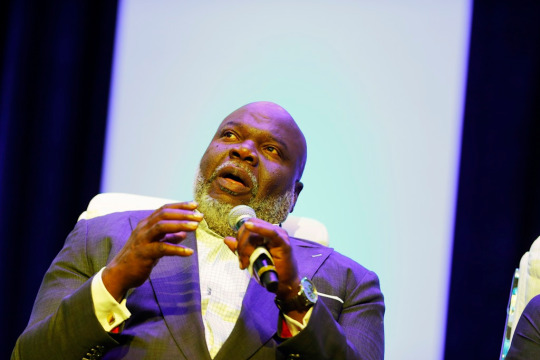
FACT CHECK
Snopes: AI-fueled videos spread rumors on bishop
Dallas megachurch pastor’s association with Combs assailed
Some social media videos spreading “false and unfounded rumors” about Dallas megachurch pastor T.D. Jakes in recent months were at least partially created using artificial intelligence, according to a report last week from the fact-checking website Snopes.
Several of the videos posted and shared by TikTok and YouTube users said Jakes resigned from The Potter’s House after being mentioned in a lawsuit against producer Sean “Diddy” Combs.
In reality, Jakes remains senior pastor of the church and preached at its most recent Sunday service.
One YouTube video from April has been viewed more than 845,000 times.
It uses a thumbnail falsely suggesting a news anchor broadcast the development around Jakes’ resignation during a TV segment, Snopes reported.
Snopes also concluded that the video’s script, editing and narration appear to have been done by AI tools.
Another YouTube video from the same month uses a thumbnail image that appears to be AI-generated and shows Jakes and Combs holding hands while shirtless, Snopes reported.
Combs’ hand and wrist in the image appear severely distorted, a telltale sign of AI.

Jordan Hora, director of communications for The Potter’s House, declined to comment on the Snopes report and referred instead to past statements on unsubstantiated rumors involving Jakes.
In response to a rumor that Jakes participated in “sex parties” hosted by Combs, Hora told The Christian Post in December that “recent claims circulating on pockets of social media about Bishop T.D. Jakes are unequivocally false and baseless.”
In February 2024, Jakes was mentioned once in a 73-page lawsuit against Combs but was not named as a defendant.
The suit says Combs “planned to leverage his relationship with Bishop T.D. Jakes to soften the impact on his public image” in the wake of a lawsuit filed by Cassie Ventura accusing Combs of sexual and physical abuse.
Combs’ Los Angeles and Miami homes were raided by federal agents in March as part of a sex trafficking investigation.
He is the subject of several lawsuits that have accused him of sexual assault and sex trafficking.
In Sunday’s service at The Potter’s House, Jakes appeared to respond to a surveillance video published by CNN last week that showed Combs assaulting Ventura at a hotel in 2016.
‘Debauchery’
“When I saw the images that have been floating all over the news all week, it became difficult to watch — the atrocious, degrading, demeaning debauchery,” he said.
“I know who it was, but I saw my daughters. As a man, I saw my daughters, and it made me angry,” he said.
At a Christmas Eve service last year at The Potter’s House, Jakes appeared to respond to the rumor about him participating in “sex parties” hosted by Combs.
“I’m not going to let the rain stop me. I’m not going to let the weather stop me. And I’m sure not going to let the liars stop me,” Jakes said.
“The worst that could happen, if everything was true, all I got to do is repent sincerely, from my heart,” he said. “There’s enough power in the blood to cover all kinds of sin. I don’t care what it is, the blood would fix it. But I ain’t got to repent about this.”
In November 2022, Jakes attended Combs’ 53rd birthday party, a representative for Jakes confirmed to The Christian Post, and video of him at the party was circulated on social media.
Past partnerships

Derrick Williams, executive vice president of entertainment at T.D. Jakes Enterprises, told The Christian Post in December 2023 that he attended Combs’ birthday party with Jakes.
“We both greeted the family, Bishop Jakes recorded a brief celebratory birthday video and left immediately to take our other scheduled meetings. Any accusation to the contrary is wholly unsubstantiated, unverified and false.”
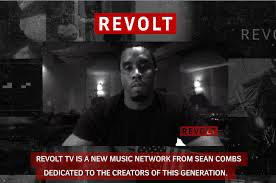
In 2021, Jakes partnered with Revolt Media, a cable TV network co-founded by Combs, for a sermon series called “Kingdom Culture with T.D. Jakes.”
Combs stepped down as chair of Revolt Media in November 2023 and reportedly sold his stake in the company in March.
Jakes founded The Potter’s House in 1996 and it now has 30,000 members, according to its website.

0 notes
Text
AI Data Science: Innovations Shaping the Future
In today's world, technology is advancing at an astonishing pace, and one of the most exciting areas of development is AI Data Science. This field combines the power of artificial intelligence (AI) with the insights of data science to create groundbreaking innovations that are shaping the future of industries across the globe. Let's delve into this fascinating world, exploring its key concepts, applications, and the impact it's having on our lives.
What is AI Data Science?
AI Data Science is a blend of two powerful fields: artificial intelligence and data science. Artificial intelligence is all about creating machines that can learn, reason, and make decisions, much like humans. On the other hand, data science involves extracting knowledge and insights from large volumes of data. When these two fields come together, we get AI Data Science, which aims to develop intelligent systems that can analyze, understand, and act on vast amounts of data.
How Does AI Data Science Work?
At the heart of AI Data Science are algorithms—sets of instructions that tell machines how to learn from data and make decisions. These algorithms are fed with massive datasets, allowing them to recognize patterns, make predictions, and even improve themselves over time. For example, in healthcare, AI Data Science algorithms can analyze patient data to predict potential illnesses, recommend personalized treatments, and enhance overall healthcare outcomes.
Applications of AI Data Science
Healthcare: In the medical field, AI Data Science is revolutionizing patient care. From diagnosing diseases earlier to personalizing treatment plans, AI algorithms are helping doctors make more accurate and timely decisions.
Finance: Banks and financial institutions use AI Data Science to detect fraudulent activities, predict market trends, and offer personalized financial advice to customers.
Retail: AI Data Science powers recommendation systems that suggest products to customers based on their past purchases and preferences. This enhances the shopping experience and increases sales for retailers.
Manufacturing: In manufacturing, AI Data Science optimizes production processes, predicts maintenance needs for machinery, and ensures quality control.
Transportation: Self-driving cars rely on AI Data Science to navigate roads, detect obstacles, and make split-second driving decisions.
Innovations in AI Data Science
Natural Language Processing (NLP): NLP allows machines to understand and generate human language. Virtual assistants like Siri and Alexa use NLP to respond to voice commands and carry out tasks.
Computer Vision: This technology enables machines to interpret and understand visual information from images and videos. Applications range from facial recognition for security purposes to autonomous drones for surveillance.
Reinforcement Learning: In this approach, machines learn by trial and error, similar to how humans learn. Reinforcement learning powers autonomous robots that can navigate complex environments and learn new tasks.
Generative Adversarial Networks (GANs): GANs consist of two neural networks that compete against each other. They are used to create realistic images, videos, and even music.
Impact on Society
The impact of AI Data Science on society is profound. While it brings tremendous benefits, such as improved healthcare, smarter cities, and more efficient businesses, it also raises important ethical considerations. Issues such as data privacy, algorithm bias, and job displacement due to automation require careful attention as we continue to integrate AI Data Science into our lives.
Future Trends
Looking ahead, the future of AI Data Science is bright. We can expect even more sophisticated algorithms, faster computing power, and increased integration into everyday devices. From AI-powered smart homes to advancements in personalized medicine, the possibilities are endless.
Conclusion
AI Data Science is a game-changer, revolutionizing industries and reshaping the way we live and work. By harnessing the power of artificial intelligence and data science, we are unlocking new opportunities for innovation and discovery. As we navigate this exciting frontier, it's crucial to ensure that these technologies are developed and used responsibly, with a focus on benefiting society as a whole.
With AI Data Science at the helm, the future looks brighter than ever before.
0 notes
Text
Key strategies for building cyber resilience in 2024 - CyberTalk
New Post has been published on https://thedigitalinsider.com/key-strategies-for-building-cyber-resilience-in-2024-cybertalk/
Key strategies for building cyber resilience in 2024 - CyberTalk
By Deryck Mitchelson, EMEA Field Chief Information Security Officer, Check Point Software Technologies.
Cyber resilience is more than just a buzzword in the security industry; it is an essential approach to safeguarding digital assets in an era where cyber threats are not a matter of “if” but “when”.
According to Check Point’s 2024 Cyber Security Report, in 2023 we witnessed a 90% increase in victims of ransomware attacks who were publicly extorted for compensation. While cyber security is a critical pathway through which to bypass ransomware, another dimension of the story that merits discussion is the resilience component.
Resilience encompasses the ability of an organization to maintain its core functions – not just in the immediate aftermath of attacks, but also during recovery from them. It is about being prepared for the inevitable breach, and recognizing that every system, no matter how robust, has potential vulnerabilities.
Roughly 4 in 10 (39%) of global businesses say they aren’t resilient enough to handle a sophisticated cyber attack. As attack methods evolve and increasingly utilize artificial intelligence, the actual figure indicating lack of preparedness may prove much higher.
Some businesses may think they are well prepared if they have a secure perimeter, but resilience is less about the first line of defence, and more about how well businesses can absorb risk and cope with mounting threats. Fending off one attack does not equal resilience.
The essence of cyber resilience lies in its dual focus. On one hand, it involves fortifying operations against constant attacks, ensuring business continuity under what can be considered “normal” cyber warfare conditions.
On the other, it demands a robust strategy for post-breach scenarios. This means having a plan that goes beyond mere recovery, one that adapts and evolves in response to the incident. Such a strategy acknowledges that the digital landscape is a dynamic battlefield, where threats evolve and so must defences.
The role of leadership in cyber resilience
Leadership plays a pivotal role in shaping an organization’s approach to cyber resilience. It’s not just about having a technically sound cyber security team; it’s about fostering a culture where cyber resilience is ingrained in every decision and action. This starts at the top, with board members and executives who don’t just passively endorse cybersecurity strategies but actively engage with them.
Effective leaders understand that cybersecurity is not a siloed IT issue but a critical business function that impacts every aspect of the organization. They ensure that cyber security discussions are not relegated to the IT department alone but are a regular feature of boardroom conversations.
Moreover, leaders in this field recognize the importance of being proactive rather than reactive. They don’t wait for an incident to occur to appreciate the value of a resilient cybersecurity posture. Instead, they invest in continuous education, staying abreast of emerging threats and adapting their strategies accordingly.
This proactive stance involves not only understanding the technicalities of cyber threats but also appreciating their potential business impact. By doing so, they can make informed decisions about where to allocate resources, how to develop their teams and when to implement new technologies or strategies, ensuring that the organization’s cyber resilience is always a step ahead of potential threats.
Technological and human elements of cyber resilience
When it comes to resilience, technology and human expertise must work in tandem. While advanced technological solutions like AI and machine learning are indispensable in identifying and responding to threats swiftly, the human element remains irreplaceable.
This synergy is crucial; technology can provide the tools and automation necessary for efficient threat detection and response, but it is the human insight that contextualizes and interprets these threats within the unique framework of each organization. Staff training, capacity management and a keen understanding of the organization’s specific risk landscape are as vital as the technology deployed to protect it.
The human aspect also extends to fostering a security-aware culture within the organization. This involves regular training and awareness programmes to ensure that all employees, not just the IT staff, understand the role they play in maintaining cybersecurity.
Overall, it’s about creating an environment where cybersecurity is everyone’s responsibility, and where employees are equipped to recognize and report potential threats. Such an approach not only strengthens the organization’s defence against external threats but also helps in mitigating risks posed by insider threats, whether intentional or accidental.
Frameworks and strategies for enhanced resilience
Adopting comprehensive frameworks and strategies is also essential for building a robust cyber resilience infrastructure. Frameworks like NIST2 and MITRE offer structured approaches, guiding organizations through the complexities of cybersecurity and resilience.
In the US, the National Institute of Standards and Technology (NIST) provides comprehensive guidelines and frameworks for cybersecurity, including the widely recognized NIST Cybersecurity Framework. This framework offers a flexible approach to managing cybersecurity risks, emphasizing the importance of identifying, protecting, detecting, responding, and recovering from cyber incidents.
MITRE, on the other hand, is known for its MITRE ATT&CK framework, a globally accessible knowledge base of adversary tactics and techniques based on real-world observations. This framework is used as a foundation for the development of specific threat models and methodologies in the cybersecurity community, helping organizations to understand and prepare for potential attack scenarios.
Both frameworks help in identifying vulnerabilities, setting priorities and implementing measures that go beyond conventional defence mechanisms. They encourage a holistic view of cybersecurity, encompassing not just technical defences but also aspects like risk management, incident response and recovery strategies.
By aligning with such frameworks, organizations can develop a more nuanced understanding of their cybersecurity position, enabling them to anticipate, withstand, and recover from adverse cyber events more effectively. This strategic alignment ensures that cybersecurity efforts are not just about meeting compliance standards but are tailored to the specific needs and challenges of the organization, thereby enhancing overall resilience.
Future-proofing against emerging cyber threats
Safegaurding against emerging threats is a critical component of cyber resilience. This requires organizations to stay vigilant and adaptive, anticipating not just current threats but also preparing for future challenges.
The rise of sophisticated AI-driven attacks, for instance, necessitates a forward-thinking approach where defence mechanisms are continuously updated and refined. Organizations must also consider the broader geopolitical landscape, which can influence the nature and frequency of cyber threats.
By integrating advanced technologies, continuous learning and strategic planning, organizations can develop a resilience posture that not only addresses today’s threats but is also agile enough to adapt to the unknown challenges of tomorrow.
This proactive approach to cyber security ensures that organizations are not just responding to threats, but are always a step ahead, ready to counteract and mitigate the risks in this dynamic digital era.
This article was originally published by the World Economic Forum and has been reprinted with permission.
#2023#2024#agile#ai#amp#approach#Article#artificial#Artificial Intelligence#assets#automation#awareness#board#breach#Building#Business#business continuity#Check Point#Check Point Software#chief information security officer#CISO#Community#compliance#comprehensive#continuous#cyber#cyber attack#cyber security#Cyber Threats#cyber warfare
0 notes
Text
The Ethical Considerations of AI: Navigating Bias and Fairness
As we move toward a future where intelligent machines hold the reins of decision-making, a pressing concern overshadows the promise of smarter and more equitable systems: the spectre of bias. AI learns from data, and if that data carries inherent biases from human history and societal structures, it can adopt and even amplify those biases.

It is critical that we understand the complex landscape of bias in AI and work tirelessly to mitigate these problems for a more equitable future. This means focusing on the non-maleficence principle, which focuses on ensuring that benefits from AI use are distributed equitably and that burdens are not disproportionately assigned to less-privileged groups.
Addressing techogle.co bias in AI requires a comprehensive approach, with developers, researchers, policymakers, and society all playing a role. The key to reducing the risk of harms from biased AI is establishing responsible processes that can mitigate bias, including transparency and inclusivity. This will require a combination of technical tools and operational practices such as internal red teams or third-party audits.
Bias in AI is caused by a number of factors, including the nature of the task, how the system is trained, and the types of data used. The most common forms of bias are racial, gender, and socioeconomic. In addition, the broader context in which a task is performed can also cause bias.
The most common type of bias is racial, which can be caused by how the task is designed or by what kind of data it is fed. For example, if an AI system is designed to identify the best job candidates, it might be biased against women or people of color. Additionally, training the system with a limited set of data could result in the same bias.
Another form of technology website bias is sexist, which can be caused by the task itself or by the data it is trained on. For example, if an AI is used to assess creditworthiness or insurance risks, it may be biased against female applicants. Finally, socioeconomic bias can occur when an AI is trained on limited datasets or in geographic areas where certain populations are underserved.
These kinds of bias can have significant consequences for meaningful work. They can reduce the experience of service to others, diminish the experience of self-actualization through work, and degrade overall work meaningfulness. This can be particularly pronounced when workers are implicated in injustices perpetrated by the technology, either through their involvement with it or because of their responsibility for its operation. This type of harm is especially important to recognize because it undermines confidence in the neutrality and fairness of our legal systems, for example, where an automated legal system might predict a defendant will be found guilty. This would violate the non-maleficence principle because it is a direct violation of one of the three fundamental ethical principles of our society: the non-discrimination, non-maleficence, and beneficence. (Parker and Grote, 2022) – the same issues would apply to any system that has the power to impact the lives of individuals.
1 note
·
View note
Link
0 notes
Text
Artificial Intelligence (AI) and Social Responsibility: Encouraging Ethical AI Use
As artificial intelligence (AI) continues its revolution in various industries, the ethical dimensions of its deployment have become central to discussions surrounding innovation and societal impact. The growing awareness of AI misconduct has sparked a public outcry for a more responsible and sustainable approach to AI utilization.
In a time when artificial intelligence affects healthcare, banking, and other essential areas, the ethical requirement is becoming clear. By delving into the ethical nuances of AI, we aim to illuminate the path toward a future where technological progress aligns harmoniously with human values, ensuring that AI serves as a force for positive change while respecting the fundamental rights and dignity of individuals.
Why is AI Important Today?
Artificial Intelligence (AI) holds immense significance today due to its transformative impact across various domains, influencing how we work, live, and interact with technology. Several factors contribute to the importance of AI in the contemporary world:
Efficiency and Automation: AI's ability to automate repetitive tasks significantly enhances efficiency and productivity. It is crucial across manufacturing, healthcare, finance, and logistics to streamline operations and reduce manual workloads.
Data Analysis and Insights: The capability of AI to analyze vast amounts of data in real-time is pivotal for deriving meaningful insights. It empowers businesses to make informed decisions, optimize strategies, and uncover valuable trends, contributing to data-driven decision-making.
Security and Fraud Prevention: Artificial intelligence enhances cybersecurity by detecting and preventing fraudulent activities. Its advanced algorithms can identify anomalies, secure digital systems, and provide a robust defense against cyber threats.
Innovative Solutions: AI fosters innovation by facilitating the development of advanced applications and solutions. From natural language processing to autonomous systems, AI technologies drive creativity and ingenuity, leading to breakthroughs in various industries.
Medical Advancements: In healthcare, AI contributes significantly to diagnostic accuracy, drug discovery, and personalized treatment plans. The potential for AI-driven technologies to revolutionize patient care and outcomes showcases its transformative impact on the medical field.
Ethical considerations are paramount to ensure responsible AI development and deployment. It is a driving force behind technological progress, shaping the present and future of various industries and aspects of everyday life.
What is the ethical use of AI?
The ethical use of artificial intelligence (AI) refers to the responsible development, deployment, and operation of AI systems that align with moral values, human rights, and societal well-being. It involves ensuring that AI technologies are designed and implemented in a manner that respects fundamental ethical principles and safeguards against potential harm. Some factors include:
Fairness and Bias Mitigation: Addressing and mitigating biases in AI algorithms to ensure equitable treatment across diverse populations, regardless of factors such as race, gender, or socio-economic status.
Transparency: Making AI systems transparent and understandable allows users and stakeholders to comprehend the decision-making processes of the technology.
Accountability: Establishing mechanisms for accountability when AI systems make decisions, attributing responsibility for any adverse consequences.
Privacy Protection: Safeguarding individuals' privacy by implementing measures to limit unauthorized access and use of personal data.
Security: Ensuring the robustness and security of AI systems to prevent malicious use, hacking, or exploitation.
Human Control: Maintaining human oversight and control over AI systems, especially in critical decision-making frameworks that avoid undue reliance on automated processes.
Societal Impact: Evaluating and addressing the broader societal implications of AI, including its effects on employment, inequality, and access to benefits.
Laws and regulations: Adhere to relevant laws, regulations, and ethical standards when using AI.
Ethical considerations in AI are crucial for fostering public trust, preventing unintended consequences, and ensuring that AI contributes positively to societal advancement. As AI technologies evolve, ongoing discussions and efforts around ethical practices are essential to navigate the complex ethical landscape.
Necessities of Ethical Use of AI
The ethical use of AI is essential for various reasons, reflecting the need to balance technological advancements with societal values, human rights, and responsible innovation. Vital necessities for the ethical use of AI include:
Transparency and Explainability:
Understandable Algorithms: Artificial intelligence systems need to be transparent so their decision-making processes can be explained and justified. It enables trust and mitigates potential biases.
Data Provenance: Knowing the source and characteristics of the data used to train AI models is essential to identify potential biases and ensure fairness. Openness in data usage fosters accountability and ethical development.
Fairness and Non-discrimination:
Bias Detection and Mitigation: AI systems can inherit and amplify societal biases in the trained data. Regular testing for bias and implementing mitigation strategies are critical to avoiding discriminatory outcomes.
Inclusive Development: Diverse teams of developers, researchers, and stakeholders across demographics and disciplines should be involved in AI design and implementation to ensure it represents the needs and values of various communities.
Privacy and Security:
Data Protection: Ensuring user privacy and data security throughout the AI lifecycle, from collection to storage and use, is paramount. It requires robust data governance practices and adherence to legal frameworks.
Accountability and Supervision: Mechanisms for identifying and addressing misuse of AI, holding developers and users accountable for ethical violations, and providing recourse for potential victims are essential.
Human Control and Oversight:
Human-in-the-Loop Systems: Ultimately, humans should remain responsible for decisions made using AI. AI systems should have features of human oversight and control mechanisms to prevent unintended consequences.
Social Impact Assessment: Before deploying AI, thorough assessments of its potential social, economic, and environmental impacts are crucial to address risks and maximize positive outcomes.
Public Education and Engagement:
Raising Awareness: Educating the public about AI capabilities, limitations, and potential risks and benefits is vital to foster informed engagement and trust in this technology.
Open Dialogue and Debate: Public forums and ongoing discussions about ethical challenges and responsible AI development are necessary to shape its future and ensure it aligns with societal values.
In developing and deploying AI technologies, these necessities can contribute to a more ethical, responsible, and sustainable integration of AI into society. This approach helps to build trust, mitigate risks, and maximize the positive impact of AI on individuals and communities.
Several Methods to Use AI Ethically
Securing the ethical utilization of AI requires diverse methods and strategies at every stage of AI systems' development, deployment, and operation. Below are various approaches to ensure the ethical use of AI:
Data-driven methods: Advocate for diverse and inclusive datasets to counteract biases and ensure that AI models are trained on representative data, fostering fairness and reducing disparities in outcomes.
Algorithmic and design methods: Prioritize the integration of explainable AI models, enabling users to comprehend the decision-making processes of algorithms. Transparent models enhance accountability and facilitate the identification and rectification of biases.
Policy and governance methods: Establish comprehensive policy frameworks that outline ethical AI development and deployment guidelines. These frameworks should align with legal regulations, industry standards, and ethical norms, providing a structured approach to responsible AI practices.
Education and awareness methods: Educate AI developers about ethical considerations through training programs. It includes understanding the implications of algorithmic decisions, recognizing potential biases, and promoting ethical decision-making throughout the AI development lifecycle.
Remember, there's no single "silver bullet" for ethical AI. A combination of these methods, tailored to the specific context and application, is crucial for ensuring responsible and beneficial AI development and deployment.
Conclusion
As AI technologies play a pivotal role in reshaping industries and daily life, ethical practices must remain at the forefront of technological innovation. Ongoing discussion, education, and collaboration are vital components of this excursion toward a future where AI serves as a force for positive change, supporting the well-being of individuals and communities.
As an IT company committed to delivering AI services with a strong emphasis on ethical use, AtliQ combines technical expertise with a dedication to responsible AI development. Collaborating with them as your partner in upscaling your business while fostering ethical use of AI brings you the perfect combination of productivity and ROI.
0 notes
Text
Neuralink, the implantable brain chip developed by Elon Musk
INTRODUCTION:
Elon Musk's Neuralink is a ground-breaking program that seeks to combine artificial intelligence (AI) and human brain capabilities in the field of cutting-edge technology and bold endeavors. The creation of an implantable brain chip, which is at the center of Neuralink's ambition, has many intrigued and worried about the possible ramifications of this ground-breaking technology.
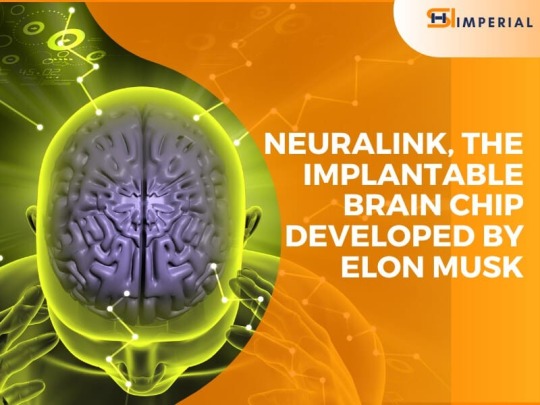
The goals include enhancing human potential, treating neurological conditions like Parkinson's or ALS, and maybe even establishing a mutually beneficial partnership between humans and artificial intelligence.
The Neural Network's Brain:
Elon Musk established Neuralink in 2016 with the goal of creating a seamless future brain-computer interface. The main objective is to treat neurological disorders and eventually improve human cognition by directly connecting the brain to external equipment.
Important Elements of the Neuralink Brain Chip:
Neuralink's concept is based on a tiny implantable device called the Neural Interface, which is intended to communicate directly with the human brain. Electrodes are contained in incredibly tiny threads that make up the device—thinner than a human hair. To create a high-bandwidth connection, these threads are surgically inserted into the brain.
Redefining Neurological Treatments:
Neuralink's principal objective is to transform the way neurological diseases are treated. The brain chip has the potential to treat epilepsy, improve movement and functionality for people who are paralyzed, and offer innovative treatments for a range of neurological conditions, all of which would greatly enhance the quality of life for those who are impacted.
Bidirectional Brain-Machine Communication(BMI):
The brain and external devices can communicate in both directions thanks to Neurolink's brain chip. This innovative function enables information to be sent back to the brain in addition to reading neural signals. This ushers in a new era of adaptable and interactive technologies that can work in perfect harmony with the human intellect.
Possibility of Neural-Computer Cooperation:
The technology developed by Neurolink creates the groundwork for a new phase of brain-computer coperation. The distinction between artificial and human intelligence may become more hazy as a result of this partnership, resulting in more natural and effective interactions with digital technologies. This smooth transition has effects in a variety of domains, including professional work, education, and artistic pursuits.
Enhancing Research on Brain-Computer Interfaces:
Neurolink makes a major contribution to the field of brain-computer interfaces (BCIs) with its efforts. Neurotechnology is being pushed to its limits by the research and development needed to create a brain chip that is both safe and dependable. This development affects the scientific community and our comprehension of the brain in larger ways.
Cognitive Enhancement:
Neuralink's brain chip has the potential to improve cognitive function in areas other than medicine. By facilitating seamless interaction between users and external devices, the technology has the potential to enhance cognitive abilities and pave the way for the discovery of new frontiers in human intellect.
Difficulties and Ethical Issues:
Risks and Surgical Procedures:
Because Neuralink's brain chip installation requires surgery, there are worries over the potential risks involved. Critics draw attention to the risks involved and the necessity of strict safety protocols when using such cutting-edge technologies.
Privacy and Security:
There are a lot of privacy and security issues because of the direct connection between the brain and external equipment. It becomes critical to protect the data sent between the brain and linked systems, which calls for strong encryption and defense against unwanted access.
Ethical AI Use:
As Neuralink progresses in integrating AI with the human brain, ethical questions about the proper application of AI technologies become increasingly important. Making sure AI applications respect human rights and values is a difficult task that needs to be carefully considered.
Informed Consent and Autonomy:
Neuralink's brain chip is optional, which raises concerns regarding informed consent and personal autonomy. An important ethical challenge is striking a balance between giving people access to transformational medical treatments and guaranteeing them complete autonomy over their decisions.
CONCLUSION:
The implantable brain chip developed by Neuralink is a groundbreaking innovation that has the potential to completely change the fields of neuroscience, medicine, and human-machine interaction. Even if the technology has a lot of potential to treat neurological conditions and improve cognitive capacities, managing ethical issues, guaranteeing safety, and maintaining personal liberty will be crucial to navigating the long-term effects of this ground-breaking project. The social and ethical implications of brain-machine interfaces will need to be carefully considered as Neuralink pushes the envelope of what is conceivable.
#Neuralink#Brain#Chip Developed#Elon Musk#Implantable Brain#Human Brain#Combine Artificial#Musk's Neuralink
0 notes
Text
Can AI Help End the Illicit Tobacco Trade?

The illicit tobacco trade is a global scourge, costing governments billions of dollars in lost revenue and fueling organized crime. It's estimated that one in ten cigarettes smoked worldwide is illegal, and the problem shows no signs of slowing down. But in the fight against this shadowy industry, a new weapon has emerged: artificial intelligence (AI).
The Scope of the Problem
The illicit tobacco trade is a complex web involving criminal organizations, corrupt officials, and counterfeiters. They operate across borders, exploiting loopholes in regulations and using sophisticated methods to evade detection. The consequences are far-reaching, impacting public health, national security, and economic development.
Health Risks: Illicit cigarettes often contain higher levels of harmful chemicals than legal ones, posing a significant health risk to smokers.
Lost Revenue: Governments lose billions of dollars in tax revenue from the sale of illegal tobacco, hindering their ability to fund essential services.
Organized Crime: The illicit tobacco trade is a major source of income for criminal organizations, fueling other illegal activities like human trafficking and drug smuggling.
Enter AI: A Powerful Tool for Tackling the Illicit Trade
AI offers a range of capabilities that can be harnessed to combat the illicit tobacco trade:
Data Analysis: AI can analyze vast amounts of data from sources like customs records, financial transactions, and social media to identify patterns and anomalies indicative of illegal activity. This can help authorities pinpoint smuggling routes, track criminal networks, and predict future trafficking attempts.
Image Recognition: AI-powered image recognition software can be used to scan shipping containers, warehouses, and retail outlets for counterfeit cigarettes. This can automate the detection process and significantly improve efficiency.
Risk Assessment: AI can analyze risk factors associated with different individuals, businesses, and shipments to identify those most likely to be involved in the illicit trade. This allows authorities to focus their resources on high-risk targets.
Predictive Analytics: By analyzing historical data and current trends, AI can predict where and when the next smuggling attempt might occur. This allows authorities to be proactive and deploy resources to prevent it.
Examples of AI in Action
Several countries are already using AI to combat the illicit tobacco trade. For instance:
The United States: The US Customs and Border Protection Agency uses AI to analyze shipping manifests and identify suspicious shipments. This has led to the seizure of millions of illegal cigarettes.
The United Kingdom: The UK's HMRC (Her Majesty's Revenue & Customs) uses AI to track the movement of tobacco products and identify tax evasion. This has resulted in millions of pounds in recovered revenue.
China: China is developing an AI-powered system to track the production and distribution of cigarettes. This system is expected to significantly reduce the sale of counterfeits.
Challenges and Considerations
While AI holds immense promise, it's important to acknowledge the challenges:
Data Quality and Bias: The effectiveness of AI depends on the quality and accuracy of the data it's trained on. Biased data can lead to inaccurate results and reinforce existing inequalities.
Privacy Concerns: The use of AI raises concerns about data privacy and the potential for misuse. It's crucial to ensure that data is collected and used ethically and responsibly.
Cost and Implementation: Implementing AI solutions requires significant investment in infrastructure and expertise. This can be a barrier for developing countries with limited resources.
The Road Ahead
Despite the challenges, AI has the potential to be a game-changer in the fight against the illicit tobacco trade. By harnessing its capabilities responsibly and ethically, we can create a safer and healthier world for everyone.
Let's work together to make the illicit tobacco trade a thing of the past. By using AI responsibly and ethically, we can build a healthier and more just world.
#artificial intelligence#machine learning#deep learning#technology#robotics#tobacco#tobacco industry#smoking#cigarette
0 notes
Text
How to prevent LED screen information security?
LED screen is an important tool in the field of information dissemination today. Its characteristics such as high-speed transmission, wide coverage, high brightness, high definition, high contrast and large-area seamless splicing make it a leader in display equipment. However, some people use LED displays to broadcast bad and unsafe messages. So, how to prevent the insecurity of LED screen information? This not only involves the responsibility of the end customer, but also requires the cooperation of LED display manufacturers.

At around 10 a.m. on April 8, 2019, the LED screen in the emergency department of Gaoyang County Hospital suddenly played insulting remarks against China. The county hospital immediately cut off the power supply and called the police. Similar situations are not isolated. As early as 2015, indecent videos were played on the LED screens of Zhejiang Plaza, causing serious negative impacts on society.
As LED screen technology continues to mature and LED display manufacturers launch new products equipped with new technologies such as interaction, AR/VR, AI, 3D, face recognition and touch, LED displays are becoming more and more widely used. . However, if these screens were tampered with or spread false information, the consequences would be disastrous. Therefore, the safety issues of LED displays need to be solved urgently, which requires the joint efforts of LED display manufacturers and end customers, as well as the supervision of the general public. Here are the wireless LED display technology answers.

Unsafe information mainly comes from network attacks. Although my country's network security level continues to improve, with the development of information technology, security threats and traditional security issues still exist. In order to reduce the information security risks of LED screens, it is necessary to strengthen the review of public information, especially in places with dense flow of people, such as squares, pedestrian streets and commercial streets. In addition, the hidden dangers of information played on LED displays may come from unprofessional operations of operators, or criminals deliberately playing illegal information through network attacks.

In order to solve these problems, the following preventive measures can be considered. First, greater scrutiny of public information, especially in high-traffic areas. Secondly, LED display manufacturers can develop secure terminal systems to ensure information security. This system should release media information remotely and automatically by the terminal software. Each media played should have its own data fingerprint and can only be played after verification to ensure the security of the LED display information. Teach you 10 guidelines for choosing LED display manufacturers in 2023.
In addition, specific devices can be designated and bound as playback terminals, and the LED display screen is not allowed to be controlled by other devices. Limiting the functions of the device and prohibiting the use of mice and USB removable storage devices can reduce the risk of information leakage on the LED display. LED display manufacturers should set up a dedicated safety guidance group to train end customers and provide methods to solve common faults, as well as the skills to remotely cut off power.

End customers need to establish an emergency plan mechanism, involving LED display manufacturers, system manufacturers and engineers. When the LED display screen plays unsafe information, the system's feedback mechanism should be able to delete the problematic media in a timely manner to reduce losses. In general, LED screen information security issues require the joint efforts of manufacturers, system vendors, end users and the general public to pay attention to network information security and prevent the spread of unsafe information.
Thank you for watching. I hope we can solve your problems. Sostron is a professional LED display manufacturer. https://sostron.com/about We provide all kinds of displays, display leasing and display solutions around the world. If you want to know: Five major chip issues that need to be solved for small-pitch LED screens. Please click read.
Follow me! Take you to know more about led display knowledge.
Contact us on WhatsApp:https://api.whatsapp.com/send/?phone=8613570218702&text&type=phone_number&app_absent=0
0 notes
Text
Alternate UNITverses
Funny thing came up while I was working on chapter 33 of my long-running Doctor Who fic, My Cosmos is Yours (aka Cosmosgate). I wanted to make a reference to the events of the Big Finish audio UNIT: Shutdown but I couldn't find a detailed enough recap of what exactly happened to the Tower of London after the big battle in the third disc. I vaguely remembered some dialogue about it in the fourth disc, but I didn't have the time to listen to the whole thing, so I asked Google's AI, Bard, to find the information for me.
Of course what it did was both much less helpful and quite a bit more interesting; it didn't find a definitive answer, so it made shit up.
Below are two of the "drafts" it gave me. In both, the Tower of London was badly damaged and had to be rebuilt, but the outcome is very different. Most saliently, in the first, UNIT ends up relocating to a different building outside the city, whereas in the second, UNIT doubles down on using the Tower as its HQ.
I guess the Anniversary Special decided to do a mix of the two; new building, but in the heart of the city...
Option 1
After the events of the Big Finish audio drama UNIT: Shutdown, the Tower of London sustained significant damage. The battle between UNIT and the alien horde left many parts of the Tower in ruins, and several of its historic buildings were destroyed.
The British government was quick to begin the process of rebuilding the Tower, and within a few years, it was largely restored to its former glory. However, the events of Shutdown had left a lasting mark on the Tower, and it would never be quite the same again.
The Tower's role as a military base was also changed after Shutdown. The government decided that it was too dangerous to have such a valuable target located in the heart of London, and so UNIT was relocated to a new facility outside of the city.
Despite the damage it suffered, the Tower of London remains a popular tourist destination, and its history continues to fascinate people around the world.
In the aftermath of Shutdown, the Tower of London was placed under lockdown while the government assessed the damage and made plans for its restoration. The public was not allowed to visit the Tower for several months, and when it finally reopened, the number of visitors was significantly lower than before.
The government also took steps to improve the security of the Tower, installing new surveillance systems and increasing the number of guards. These measures were unpopular with some members of the public, who felt that they made the Tower less welcoming.
Despite the challenges it faced, the Tower of London gradually recovered from the events of Shutdown. By the early 2020s, it was once again a popular tourist destination, and its history continued to fascinate people around the world.
The events of Shutdown also had a lasting impact on UNIT. The organization was forced to reassess its role in protecting the UK from extraterrestrial threats, and it began to focus more on developing new technologies and training its personnel.
UNIT also became more involved in international cooperation, working with other organizations around the world to share information and resources. This cooperation proved to be invaluable in the years that followed, as UNIT and its allies faced a number of new and dangerous threats.
The events of Shutdown were a major turning point for the Tower of London and UNIT. The organizations were forced to adapt to a changing world, and they emerged stronger and more resilient than ever before.
Option 2
The Tower of London remained a secure and operational stronghold of UNIT after the events of the Big Finish audio UNIT: Shutdown. Although the tower was severely damaged in the battle against the alien invaders, it was quickly repaired and reinforced by UNIT engineers. The tower's importance as a strategic military position and its historical significance as a symbol of British power made it a vital target for the aliens. However, UNIT was able to successfully defend the tower and prevent the aliens from gaining a foothold in London.
As a result of the conflict, the Tower of London underwent several security upgrades to better defend against future attacks. New security systems were installed, and UNIT increased its presence at the tower. The tower also became home to a new UNIT research facility, which was tasked with studying the alien technology that was recovered during the battle.
The events of UNIT: Shutdown had a profound impact on the Tower of London. The battle served as a reminder of the tower's importance as a military base and historical landmark. It also highlighted the importance of UNIT's role in protecting the United Kingdom from extraterrestrial threats. The tower remained a symbol of British power and resilience, and it continued to serve as a vital part of the country's defenses.
Here are some of the things that happened to the Tower of London after the events of UNIT: Shutdown:
UNIT increased its presence at the tower, with more soldiers and scientists stationed there.
New security systems were installed, including advanced surveillance equipment and motion detectors.
The tower's defenses were strengthened, with new blast doors and reinforced walls.
A new UNIT research facility was built on the grounds of the tower, where scientists studied the alien technology that was recovered during the battle.
The Tower of London became a training ground for UNIT soldiers, who were taught how to defend against extraterrestrial threats.
The events of UNIT: Shutdown had a lasting impact on the Tower of London. The tower became a more secure and well-defended stronghold, and it continued to serve as a vital part of the United Kingdom's defenses. The tower's role in the battle against the alien invaders made it a symbol of British resilience and determination, and it continued to inspire people for generations to come.
1 note
·
View note
Text
The differences between Takato and Haru

(This meta was requested by @digitalgate02, who also assisted me with a large portion of it. Thank you for your help!)
Takato and Haru often beg a lot of comparisons because of the fact they go so against the usual “brash hero” archetype common to not only Digimon but also shounen franchises in general, being significantly more mild-mannered (on a language level, they’re also the only Digimon protagonists to date who use the more polite boku first-person pronoun instead of the more assertive ore). Haru himself even points out in Appmon’s very first episode that this kind of personality would normally be more suited towards a side character than a protagonist!
Because of that, Haru is often considered to be a spiritual rehashing of Takato, and many have tried to make close parallels between the two, but while the desire to make comparison is naturally understandable, the truth is that beyond surface temperament, the two characters actually have very little in common. In fact, both Tamers and Appmon take rather different approaches to their definitions of a “conventional hero”, and that results in both Takato and Haru having very different roles in the plot.
In many cases, the role of a protagonist in a narrative has a deep relationship with what kind of narrative it is in the first place, and especially what kinds of themes it wants to present. For instance, in the case of 02, you could argue that the story is more “about” Ken than it is about Daisuke, since both major arcs in the story are about his fall and reformation, but when you consider the major themes present in 02′s narrative about purpose in life and pragmatism, Daisuke’s way of life and overall attitude are vital elements in relation to them, and it’s why he ends up being the “protagonist” (or, more accurately, the character at the forefront of the story) despite Ken’s heavier connection to it.
Tamers and Appmon have a number of similarities in storytelling, mainly that they’re both “hard sci-fi” stories in comparison to other entries that have stronger fantasy elements, and do have a certain amount of crossover in terms of dealing with AI-related topics. However, the actual “nature” of each work ultimately turns out to be different, and thus impacts how each of their protagonists is presented.
I heavily dislike calling Tamers a “deconstruction” of the monster collecting genre or of Digimon Adventure, mainly because of how much that term has been exploited to stereotype works in a genre as being things they’re not, or less nuanced than they actually are (as one Twitter user aptly put it: “a deconstruction is when I like something in a genre I disrespect”). I absolutely do not care for the idea of claiming that Adventure or 02 were somehow less nuanced or “deep” than Tamers just because they were more idealistic or more subtle about it, because they sure as hell had a lot of deeper things hidden between the lines if you bother to look out for them, and I also don’t like the implication that Tamers exists to criticize Adventure for supposedly being too naive. It is true, however, that Tamers re-examines a lot of Adventure (and 02)’s concepts in a different context; while Tamers isn’t as strong of a theme narrative, and it’s much more difficult to say there's an overarching message that encompass most or all of the series as much, it does indulge in a lot of thought experiments and smaller subplots that wouldn’t be possible in Adventure, and Takato thus has an important position in facilitating those kinds of thought experiments. The overall franchise metaphors of “growing” (evolving) alongside your Digimon (or, at least, something different from you) and the symbolism associated with it are still more than present, so the Tamers way of showcasing it is in mainly presenting the question of how that kind of goal would even be achievable in the first place when things aren’t as clear-cut.
In particular, Takato serves to address how someone who doesn’t fulfill the typical protagonist mold would cope with situations that somewhat resemble those in Adventure, what would happen when a Digimon partner is fundamentally different from oneself, and how one would still be able to grow alongside such an existence. Thus, his own character arc is more relevant to his own personal growth in accordance with interacting with Guilmon and what he gets out of his journey. This is especially because one thing particularly unique to Tamers is how it portrays Digimon as significantly more feral and different in mentality to humans, which means that he had a much higher personal hurdle to begin with, and thus his personal story and what he gets out of it becomes of significantly more importance.
Appmon, on the other hand, very much is an overarching theme narrative and isn’t exactly subtle about it, with one of its biggest questions being about what’s important in a world that’s getting increasingly controlled and regulated by modern technology that’s getting more and more intelligent. Haru is thus the embodiment of Appmon’s answer to that question: “to choose to be kind” -- and the less-than-subtle invocation of the word “protagonist” ends up having a very different meaning invoked in its final episode.

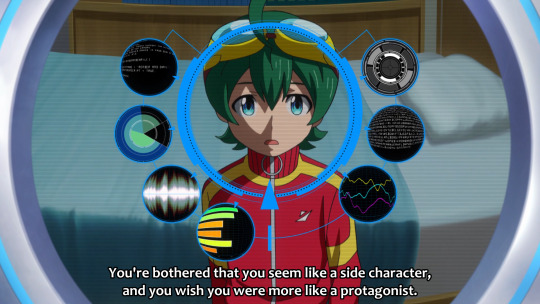
At the very least, on top of both being rather unconventional protagonists, both Tamers and Appmon do start with Takato and Haru both expressing a desire to be more like one who could go on some kind of adventure (Takato’s version isn’t as verbal, but his way of enthusiastically putting on goggles as proof that he’s a Tamer in Tamers episode 2 carries heavy implications of wanting to emulate the heroes he saw on TV).
However, this is where we get our first difference: Takato proudly claims his newfound status as the series protagonist, whereas Haru is unsure and self-conscious about it -- Haru himself is the one who initially considers himself not cut out for the role despite Yuujin personally believing he does and Gatchmon trying to urge him into it. And, in fact, this is actually the difference that kicks off where their paths entirely diverge.

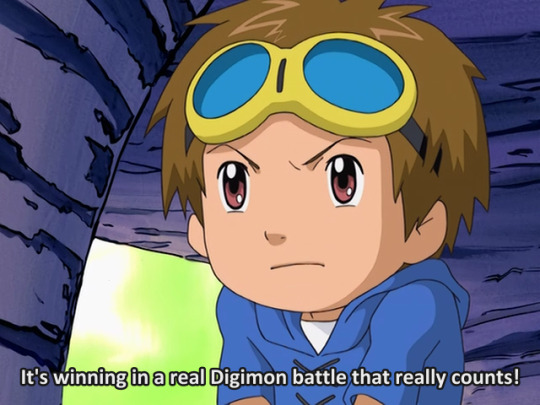
Takato is often said to be unconventional for a protagonist, but when you really think about it, it’s not like Taichi or Daisuke were exactly models of typical protagonist tropes; while you could call them “hot-blooded”, in the end, Taichi’s standout traits have more to do with natural charisma and sometimes even being too chill, and Daisuke, for all he seems assertive, is actually extremely deferential. So why is Takato still such a standout in comparison?
Well, when you look at the detailed profiles of all twelve of the main Adventure and 02 cast, you might notice something: all of them are naturally selfless people who put others before themselves without a second thought. On the other hand, when you look at Takato, you might realize that this is very much not the case, especially during the early parts of the series. As much as Takato is a “soft” person, he’s not necessarily very “kind” or “nice”, especially during the early parts of the series; he can get possessive or clingy, petty, or even a little arrogant (Tamers episode 11 basically has him go on a mini-power trip based on his card combo having worked so well in the prior episode, which ends up becoming part of his isolation from Hirokazu and Kenta in the following one). Moreover, Takato loses his emotional composure and becomes a crying mess as early as Tamers episode 2, and while it’s not like other characters in Adventure and 02 hadn’t been prone to emotional outbursts, combine it with the above facts and you get the take-home that Takato isn’t “soft” out of an active choice to be so as much as he’s just really, really lacking in emotional mettle to begin with.
To be fair to him, Takato has to deal with quite a bit more stress during the early parts of Tamers than Haru has to during the equivalent parts; having to deal with a Digimon partner that’s outright feral at times and doesn’t have a fully intelligent understanding of how to communicate is a pretty rough thing to start off with. That said, Takato is fairly cowardly even in situations that don’t necessarily have to do with this, it’s just that this makes it worse -- but it means a lot that Takato himself is willing to put in that much effort in bonding with Guilmon despite being initially intimidated by what he’d just created, and that perhaps is what’s the beginnings of how he continues to develop that strength of heart for the rest of the series (and also extends to how he’s the one who connects with Grani).


This is in contrast to how Haru is described by Yuujin at the end of Appmon episode 1, in which Yuujin states that Haru is already cut out to be a protagonist because he’s a kind person -- in other words, Takato is someone who is not cut out to be a protagonist of any kind of adventure at the start of Tamers, even though he thinks he now gets the luxury of being one due to the circumstances he’s thrust into, whereas Haru is already someone with the potential to be one even at the start of the series, but initially lacks the self-confidence to consider himself able to be so. Thus, Takato’s character arc involves having to actually grow into someone worthy of the position, whereas Haru’s involves coming to terms with the aspects of himself he already has but doesn’t quite understand yet.
One very important thing to reiterate is that “unconventional” does not necessarily mean “better” by default, and, on the flip side, just because Takato isn’t as virtuous of a person at the beginning doesn’t mean he’s a worse character (after all, these kinds of things are what makes one interesting). Rather, it’s more important to consider why these characters are this way based on the context of the narratives they’re in.
In the case of the Adventure/02 kids, getting twelve naturally kind kids wasn’t exactly accident, nor was Haru and the other Appli Drivers also being that way; said kids have a bit of selection bias in that they were deliberately chosen by various entities (”the one who wishes for stability” and the Agents, the Holy Beasts, or Minerva) knowing that a massive world- or humanity-threatening crisis was on the horizon and quite understandably picking kids who had the greatest potential for the kindness that shouldering the world’s burdens would take (in Adventure and 02 this manifested in having the kids resonate with Crests and Digimentals that represented virtues, and in Appmon this involved Minerva actively testing them). After all, it’s only natural that anyone with the chance to recruit people to help with a monumental task would ideally go out of their way to pick people who seem best suited for the job, whether it’s something as grand as fantasy chosen hero picking or something as simple as job recruitment. But at the beginning of Tamers, none of the involved parties were really aware of any kind of grand, looming threats on the horizon, and whatever the DigiGnomes were thinking (or not thinking) when giving Takato his D-Ark is arcane to us all, and so Takato ended up becoming a Tamer by functional accident, resulting him starting off very poorly equipped for the job and having to learn how to do it on the fly.


This also means that the “motives” Takato and Haru have for taking action at the beginning of the series are accordingly different. Because any concept of “stakes” was not immediately apparent at the start of Tamers, Takato’s motivations for being a Tamer are more self-centered and selfish than Haru’s are for being an Appli Driver at the start of their respective series.
Takato’s motives at the beginning of Tamers really just revolve around “I want to be able to play with Guilmon more and not lose him,” and there’s no indication at said beginning that he’s really prepared for or even understands the part about having to protect others from harm. That doesn’t mean that Takato’s a selfish person to the extent of not caring about others at all -- in fact, by the time of Tamers episode 15, he demonstrates an understanding that they’re not playing a “game” anymore when things get difficult (and even puts his foot down in front of the other kids for it, a huge improvement from his rather cowardly outlook at the beginning of the series), so the issue largely had to do with the fact that the early parts of Tamers didn’t immediately make such high stakes clear, and Takato himself was thus in a situation of not worrying about others because that necessity wasn’t there yet. But even in the same episode, Takato still has a clear motive of wanting to show off his cool Digimon partner to the others and bask in his “status” as a Tamer, and it’s still a huge contrast to Haru who was initially too humble to accept his role as part of such a larger narrative until his desire to “protect everyone” won out. It’s a big deal that Haru understood the stakes that would be involved in the fight against Leviathan from day one, and actively chose to opt in because of his selflessness.
Another major reason for this difference is that Haru has a certain character trait explicitly ascribed to him that isn’t with Takato: Haru enjoys reading books and is actually rather book-smart and intellectual. On a certain technicality, Takato being characterized as not particularly skilled in that department actually brings him a little closer to the conventional shounen protagonist archetype than it does a “bookish” character like Haru, because such a character is often considered too nerdy for the protagonist position -- but in Haru’s case, the fact he’s actively thoughtful and ruminates on things means that he spends a lot of time thinking about “what’s the right thing to do” in a given situation.
For all it’s worth, I really hope that the above won’t be taken as an implication that Takato is a fundamentally bad person for having more selfish immediate priorities than Haru or the Adventure/02 kids do; having to carry the weight of such a large thing is a huge thing to ask of someone, especially when we’re talking about someone who kind of got thrown into this whole mess and has been spending the entirety of this series trying to figure it all out without a lot of reliable sources of help. On top of that, it should also be noted that Takato is ten; if there’s anything that can be said to be not entirely true-to-life with the Adventure and 02 cast personalities, it’s that a lot of the emotional awareness and levelheadedness they exhibit usually come from people much older than 8-12 (it’s one of the “acceptable breaks from reality” employed in kids’ shows that kid protagonists are often a tad bit more mature than actual kids would be at that age, otherwise a lot of said kids’ show plots wouldn’t function), and real ten-year-olds in Takato’s situation would often have more difficulty knowing what to do with such great burdens at this age. It’s actually fairly significant that Haru is 13 and from a group composed mainly of middle schoolers, in contrast to the older series having elementary school kids (the youngest Appli Driver, Astra, is actually the same age as a classic Digimon series protagonist), and thus it’s probably not surprising that they’re more willing and able to deal with such huge issues much earlier on.

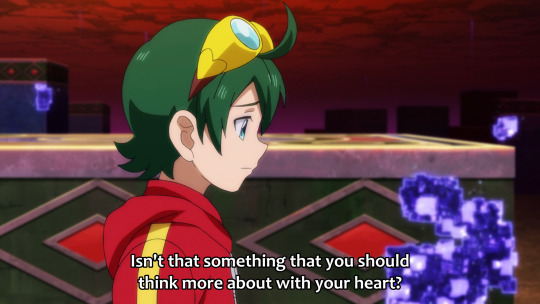
Thus, although Takato’s character arc does involve him slowly growing into the role of becoming less shallow and selfish, and becoming more truly assertive while he’s at it, this fundamental difference in their natures ends up continuing to have a major influence by the time of the later parts of the series. The difference can be most starkly illustrated in Tamers episode 35 versus Appmon episode 41 -- in which Takato, upon seeing Beelzebumon kill Leomon, is utterly consumed by his emotions and decides that the best course of action to take would be killing Beelzebumon in revenge, even though this won’t bring Leomon back or accomplish anything productive (and, indeed, it does make things worse in the form of driving his own partner over the edge and traumatizing Juri further). (Adventure had already warned that prioritizing “revenge” over “protecting others” is foolhardy and tends to cause a lot of really nasty problems.)
In contrast, one thing you might notice about Haru is that he never “denies anyone’s feelings”, even when confronting someone like Knight. You could argue that Haru wasn’t necessarily dealing with direct trauma in front of him, but recall that Knight had caused tons of grief and misery for many (something Haru takes serious offense at) and had, along with Charismon, gotten very close to permakilling all of the Buddy Appmon at one point back in Appmon episode 37 -- so it’s not like Haru doesn’t have reason to have grudge against Knight, even if the severity isn’t as immediate. Note that Haru doesn’t “both-sides” this issue; he still insists on making his own case, it’s just that he still doesn’t have it in him to not acknowledge that Knight has a good reason for making the case he does given his background, consider his words to an extent, and fight against the idea of having Knight be killed for no good reason. Haru has a very strong belief in “thinking with one’s heart” and “respecting feelings” that he'd exhibited through the entire series (for example, very prominently in Appmon episode 12 with Rei), and because of that he has a ton of emotional control over himself even taking some very harsh things. It’s clear that Haru does have very deep understanding of what he’s dealing with -- and chooses to be idealistic and kind anyway.
(In addition, because Haru is so naturally inclined to be selfless, the one time he really does hit an emotional low in Appmon episode 49, it’s not anger or lashing out at anyone, but rather sadness and despair. Haru just really does not have the fundamental capacity to be aggressive.)

As said before, Takato’s character arc is very much a personal story of how he grew into the role of a Tamer, via learning to fight for what’s important and have a strong heart for it. As a result, his motives for fighting end up still having a much more personal streak to it than anything -- at the time of Tamers episode 49, technically speaking, the Wild Bunch was still being counted on to work on the D-Reaper problem, and his own family was urging him to stay home for now, but what tipped him over the edge was not some desire to protect people as a whole but rather the fact that Juri was calling for him. It’s not to say that such a thing is selfish -- he’s clearly doing it for her sake, not anything to do with his own -- but nevertheless his involvement was directly related to something that hit a little more personally moreso than it was for the sake of the wider picture.
As said before, this is fitting for someone whose story is really more of a personal character arc before anything else; the significance is more in line with the sheer amount of emotional growth Takato had to go through in order to get to this point at all, and how someone normally so divorced from the concept of heroism could come to do something so meaningful, especially thanks to his interactions with Guilmon and growing alongside him. There’s absolutely no doubt that Takato wouldn’t have been able to do this kind of thing at the beginning of the series, so it’s a huge accomplishment that shouldn’t be watered down. It also makes him a very good foil to the D-Reaper, an emotionless program that’s still fixated on rehashing the same destructive purpose it was originally created for years ago and has long lost its purpose, and while Takato isn’t technically the sole factor in putting it to rest (at most, the most valuable asset as part of the Wild Bunch’s plan), the contrast is quite apparent.
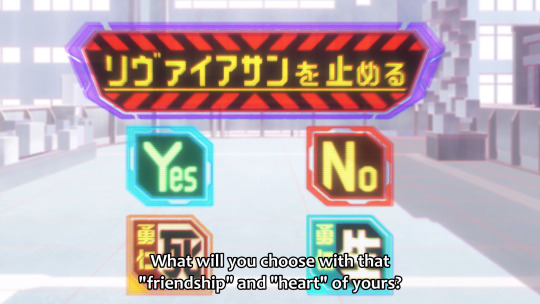
On the flip side, Appmon episode 54 not only involves the exact opposite -- in which Haru sacrifices something closely personal to him for the sake of everything else -- but also ties it very closely to its own series themes, which are assertively laid down in all of their glory during this finale. The reason Haru had been “chosen” by Minerva to begin with, and the reason he himself had been given an opt-in “choice” at the beginning of the series and again in Appmon episode 38, and so many other characters had been given “choices”, is that this story is about choices -- because Leviathan (and Knight, and any kind of “AI should manage everything” argument that this series fights hard against) believes that humans shouldn’t be allowed them, and that everything ought to fall in accordance with a “rational” system. Haru, on the other hand, believes in the human heart that can do unexpected things, and his constant choices to do things out of kindness despite understanding what they entail.
Over the course of the series, Haru hadn’t always been putting himself in a spotlight situation -- in fact, many episodes had involved him saying “we’ll support you!” and generally uplifting others before he’d ever tried to take charge. But in the end, the reason he ends up as the “protagonist” who makes the final choice for everyone’s sake is because he’s the one who understands that gravity of “making a choice with one’s feelings” that’s so vital to changing Leviathan’s mind -- plus, the fact he’d been so supportive and kind to everyone means that everyone else shows up for him when he needs it most. Note that when Astra and Eri are upset at Yuujin in Appmon episodes 48 and 51, it’s not so much out of the overall betrayal as much as the fact he specifically betrayed and hurt Haru, because that’s how much they’ve come to care for him in return.
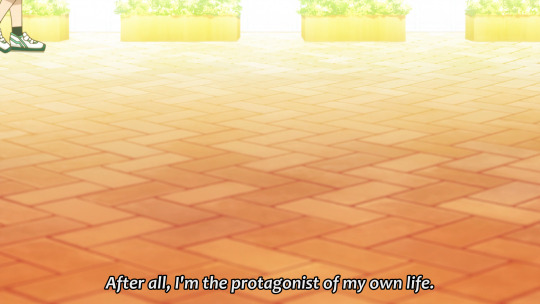

Hence, why Appmon latently ends on a frame of redefining the concept of “protagonist” -- certainly, on a meta level, Haru became the “protagonist” of the narrative that is Appmon, but what it actually means in terms of what Haru became is that everyone, including the members of the audience watching this series, is “the protagonist of their own life”, meaning that being a “protagonist” is defined merely by said act of “making choices” and defining what your own path will be. And especially in a world where singularity is going to become more and more of a real possibility -- as the show indirectly reminds us, AI surpassing human intellect is something that’s been predicted and warned about in this very world we, the viewers, live in -- understanding this is going to become even more important.

Incidentally, in the end, as much as it might be tempting to try and draw parallels with Takato because both of them are in the franchise-mandated position of “protagonist”, removing that requirement actually brings up a character that might make a much closer parallel -- “making choices that are out of kindness” easily directly invokes a certain other character from 02 who had “kindness” as a huge part of his character arc, doesn’t it...?
Really, if you think about it, Haru has a lot in common with Ken, who’s also thoughtful, intellectual, very in touch with his own feelings, assertive, resilient, strong in heart, and kind out of choice even when he doesn’t have to be -- you could basically say Haru is what Ken would be like if he hadn’t gone through such a massive formative event of trauma early in his life, or, alternatively, Ken if he had a bit more of Daisuke’s more outwardly bright, friendly, and supportive traits. It may not be a comparison you’d be easily tempted to make because, as stated above, as much as Ken had a deep connection with 02′s plot, he’s not portrayed as the protagonist of his own narrative...and, hence, Haru is unusual in that the exact archetype that was formerly placed in the role of the series deuteragonist has now been recast in the role of the protagonist itself. But then again, from Haru’s perspective, it’s not like Ken wasn’t technically the driving force of his own story, right?
(I’m not just drawing this comparison because I usually blog for 02. I promise.)
94 notes
·
View notes
Text
Tech policy is only frustrating 90% of the time
New Post has been published on https://thedigitalinsider.com/tech-policy-is-only-frustrating-90-of-the-time/
Tech policy is only frustrating 90% of the time


Many technologists stay far away from public policy. That’s understandable. In our experience, most of the time when we engage with policymakers there is no discernible impact. But when we do make a difference to public policy, the impact is much bigger than what we can accomplish through academic work. So we find it fruitful to engage even if it feels frustrating on a day-to-day basis.
In this post, we summarize some common reasons why many people are cynical about tech policy and explain why we’re cautiously optimistic. We also announce some recent writings on tech policy as well as an upcoming event for policymakers in Washington D.C., called AI Policy Precepts.
Some people want more tech regulation and others want less. But both sides seem to mostly agree that policymakers are bad at regulating tech: because they don’t have tech expertise; or because tech moves too rapidly for law to keep up; or because policymakers are bad at anticipating the effects of regulation.
While these claims have a kernel of truth, they aren’t reasons for defeatism. It’s true that most politicians don’t have deep technical knowledge. But their job is not to be subject matter experts. The details of legislation are delegated to staffers, many of whom are experts on the subject. Moreover, much of tech policy is handled by agencies such as the Federal Trade Commission (FTC), which do have tech experts on their staff. There aren’t enough, but that’s being addressed in many ways. Finally, while federal legislators and agencies get the most press, a lot happens on the state and local levels.
Besides, policy does not have to move at the speed of tech. Policy is concerned with technology’s effect on people, not the technology itself. And policy has longstanding approaches to protecting humans that can be adapted to address new challenges from tech. For example, the FTC has taken action in response to deceptive claims made by AI companies under its existing authority. Similarly, the answer to AI-enabled discrimination is the enforcement of long-established anti-discrimination law. Of course, there are some areas where technology poses new threats, and that might require changes to laws, but that’s relatively rare.
In short, there is nothing exceptional about tech policy that makes it harder than any other type of policy requiring deep expertise. If we can do health policy or nuclear policy, we can do tech policy. Of course, there are many reasons why all public policy is slow and painstaking, such as partisan gridlock, or the bias towards inaction built into the structure of the government due to checks and balances. But none of these factors are specific to tech policy.
To be clear, we are not saying that all regulations or policies are useful—far from it. In past essays, we have argued against specific proposals for regulating AI. And there’s a lot that can be accomplished without new legislation. The October 2023 Executive Order by the Biden administration tasked over 50 agencies with 150 actions, showing the scope of existing executive authority.
We work at Princeton’s Center for Information Technology Policy. CITP is home to interdisciplinary researchers who look at tech policy from different perspectives. We have also begun working closely with the D.C. office of Princeton’s School of Public and International Affairs. Recently, we have been involved in a few collaborations on informing tech policy:
Foundation model transparency reports: In a Stanford-MIT-Princeton collaboration, we propose a structured way for AI companies to release key information about their foundation models. We draw inspiration from transparency reporting in social media, financial reporting, and FDA’s adverse event reporting. We use the set of 100 indicators developed in the 2023 Foundation Model Transparency Index.
We analyze how the 100 indicators align with six existing proposals on AI: Canada’s Voluntary Code of Conduct for generative AI, the EU AI Act, the G7 Hiroshima Process Code of Conduct for AI, the U.S. Executive Order on AI, the U.S. Foundation Model Transparency Act, and the U.S. White House voluntary AI commitments. 43 of the 100 indicators in our proposal are required by at least one proposal, with the EU AI Act requiring 30 of the 100 proposed indicators.
We also found that transparency requirements in government policies can lack specificity: they do not detail how precisely developers should report quantitative information, establish standards for reporting evaluations, or account for differences across modalities. We provide an example of what Foundation Model Transparency Reports could look like to help sharpen what information AI developers must provide. Read the paper here.
New Jersey Assembly hearing on deepfakes: Last month, Sayash testified before the New Jersey Assembly on reducing harm from deepfakes. We were asked to provide our opinion on four bills creating penalties and mitigations for non-consensual deepfakes. The hearing included testimonies from four experts in intellectual property, tech policy, civil rights, and constitutional law.
We advocated for collecting better evidence on the impact of AI-generate deepfakes, content provenance standards to help prove that a piece of media is human-created (as opposed to watermarking to prove it is AI-generated), and bolstering defenses on downstream surfaces such as social media. We also cautioned against relying too much on the non-proliferation of powerful AI as a solution—as we’ve argued before, it is likely to be infeasible and ineffective. Read the written testimony here.
Open models and open research: We submitted a response to the National Telecommunications and Information Administration on its request for comments on openness in AI, in collaboration with various academic and civil society members. Our response built on our paper and policy brief analyzing the societal impact of open foundation models. We were happy to see this paper being cited in responses by several industry and civil society organizations, including the Center for Democracy and Technology, Mozilla, Meta, and Stability AI. Read our response here.
We also contributed to a comment to the copyright office in support of a safe harbor exemption for generative AI research, based on our paper and open letter (signed by over 350 academics, researchers, and civil society members). Read our comment here.
AI safety and existential risk. We’ve analyzed several aspects of AI safety in our recent writing: the impact of openness, the need for safe harbors, and the pitfalls of model alignment. Another major topic of policy debate is on the existential risks posed by AI. We’ve been researching this question for the past year and plan to start writing about it in the next few weeks.
AI policy precepts. CITP has launched a non-partisan program to explore the core concepts, opportunities, and risks underlying AI that will shape federal policy making for the next ten years. The sessions will be facilitated by Arvind alongside CITP colleagues Matthew Salganik, and Mihir Kshirsagar. The size is limited to about 18 participants, with policymakers drawn from Congressional offices and Federal agencies. We will explore predictive and generative AI, moving beyond familiar talking points and examining real world case studies. Participants will come away with frameworks to address future challenges, as well as the opportunity to establish relationships with a cohort of policymakers. See here for more information and here to nominate yourself or a colleague. The deadline for nomination is this Friday, April 5.
We thank Mihir Kshirsagar for feedback on a draft of this post. Link to cover image: Source
#2023#Administration#ai#ai act#Bias#biden#Canada#civil rights#code#Collaboration#Companies#content#copyright#course#deepfakes#defenses#Democracy#details#developers#effects#eu#EU AI Act#executive order#FDA#federal#financial#Foundation#FTC#Future#generative
0 notes
Text
Wonder Egg Priority, Episode 7: The Scars to Prove It (or, Love for the Moms, the Cutters, and the Drunks)

Wonder Egg Priority (WEP) has felt like the successor to Puella Magi Madoka Magica in many ways throughout its run, but in episode seven, it almost went full Madomagi by driving the stakes to their utmost height—to the death of one of the main characters. But as has been consistent with WEP, what it did instead, after some moments of true worry, is to instead deliver hope in the face of pain, resolve against overwhelming circumstances, and strength in weakness.
The series returns to Rika Kawai’s story in this episode, which starts with her turning 14. And on her 14th birthday, after leaving her hungover mother halfway asleep at the bar she works at and which they call home, Rika opens up to the rest of the girls, explaining that she doesn’t know her father (it could be any of five possibilities, or even more) and her mom won’t reveal any further information about him. As she trashes her mom, Neiru and Momoe are incredulous, which only drives Rika away from them. And though Ai goes to comfort her, Rika is in a terrible state of mind as she enters her next fight.
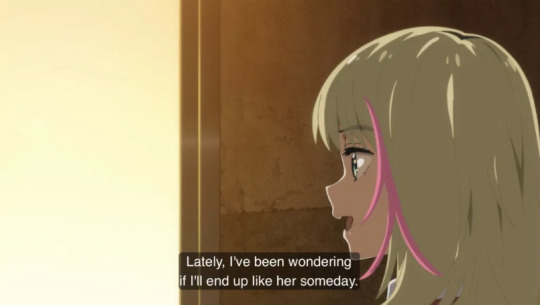
This was a difficult episode to watch. They’ve all been somewhat hard since the series never shies away from brutal and violent situations impacting young people, but I found myself squirming especially here as Rika’s cutting takes center stage. At one point, she decides to cut herself and it seems certain she will, before her turtle-like partner, Mannen, prevents it from happening.
Challenging, also, is how strained Rika’s relationship is with her mother, who’s life revolves around drink—alcohol both pays the bills and helps her forget how miserable her existence is. And in the midst of all the bad behavior in this episode—the usual Rika talk, her mom’s alcoholism and neglect, and the selfishness all around, one begins to feel deeply sorrowful for the Kawai women. Yes, Rika is often obnoxious, but her family life is in shambles, and she still exhibits goodness, including a curiously gentle relationship with Mannen. And Rika’s mother is a tragic figure, used by men and quite on the road to an early death, it would seem, unable to lift herself out of the gutter as she tries, in her own sloppy way, to protect and reach out to her daughter.

It’s in this hopelessness that Rika turns again to cutting, and then finds herself tempted by something even more dangerous. Her foe this time is a religious leader who led the egg, a follower who continues to believe in him, to commit suicide as a way of “connecting” with the universe (Heaven’s Gate, anyone?). Rika decries the ghoul as a charlatan, but is confronted with her own weakness when the egg shows her own scarred arm to Rika, revealing that she can tell that the latter cuts just like she did. And then she explains that Rika can be released from this pain.

The scars, evidence of what Rika does to cope with her pain, now become the weakness that they truly are, revealing how hopeless she feels, and how powerless she is against the mechanizations of her family life. And defeated, she’s about to allow herself to be killed when a surprising savior comes along—a turtle. Mannen attacks the spiritual leader, to Rika’s surprise as well, until she remembers that he has imprinted on her. Rika is Mannen’s mom, and as he did when he prevented her from cutting, Mannen is again protecting his mother.
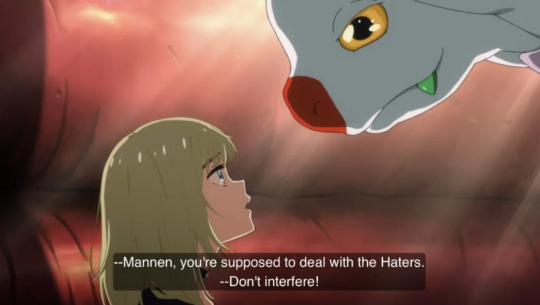
The conclusion that Rika reaches is unusual but inspiring. She understands, in this moment, the need to protect one’s mom, finally admitting to herself in a de facto way that maybe her mother is in need of love, too. It’s funny to consider the need that mothers have for love since culturally and socially, they’re always seen as the providers of it. But of course, they need it in return, especially when they falter. My own mother is sick right now, and I think of the support I need to give her and the lack of that I’ve provided through the years.
Warning: Screenshot involving cutting after the jump.
My mother was a good one, however. Rika’s, on the other hand, has struggled with the charge, which reminds me of a story from one of my favorite books, The Ragamuffin Gospel, about another bad parent—a far worse one, in fact, and a real one. I’ll quote part of the passage from chapter seven:
“‘Our daughter Debbie wanted a pair of earth shoes for her Christmas present. On the afternoon of December 24, my husband drove her downtown, gave her sixty dollars, and told her to buy the best pair of shoes in the store. That is exactly what she did. When she climbed back into the pickup truck her father was driving, she kissed him on the cheek and told him he was the best daddy in the whole world. Max was preening himself like a peacock and decided to celebrate on the way home. He stopped at the Cork ‘n’ Bottle–that’s a tavern a few miles from our house and told Debbie he would be right out. It was a clear and extremely cold day, about twelve degrees above zero, so Max left the motor running and locked both doors from the outside so no one could get in. It was a little after three in the afternoon and…’
Silence.
‘Yes?’
The sound of heavy breathing crossed the recreation room. Her voice grew faint. She was crying. ‘My husband met some old Army buddies in the tavern. Swept up in euphoria over the reunion, he lost track of time, purpose, and everything else. He came out of the Cork ‘n’ Bottle at midnight . He was drunk. The motor had stopped running and the car windows were frozen shut. Debbie was badly frostbitten on both ears and on her fingers. When we got her to the hospital, the doctors had to operate. They amputated the thumb and forefinger on her right hand. She will be deaf for the rest of her life.'”
Max—a real person, mind you—was a successful, well-liked man, but his drinking problem led to an unconscionable decision and profound failure as a parent. And yet, this book is about grace, an idea which to humans feels unjust, but which has the power to change hearts and tear down walls, sometimes literally.
Could Max be given grace? Could Rika’s mother? If not directly, she’s done her own physical damage to her daughter in the form of those cutting scars (difficult and perhaps triggering images below). As mentioned earlier, the egg that she’s helping knows her pain and insists that letting go of everything, including life itself, is the way to peace. After all, to a young, suffering girl, what else could these scars mean?



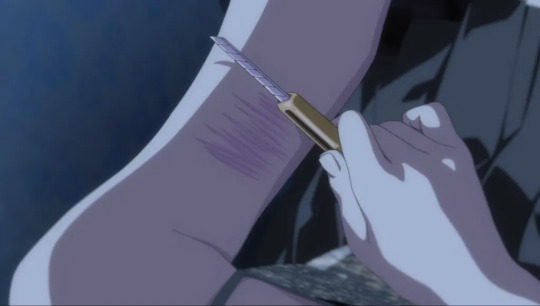



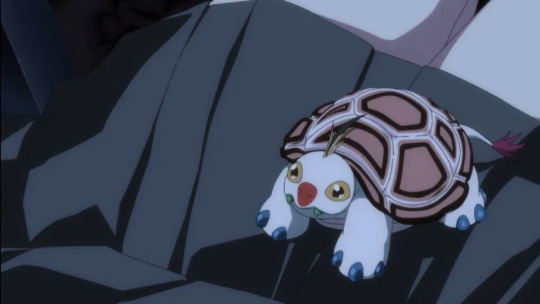
But in the midst of giving up, in the moment that she actually capitulates (and this episode takes you 99% to the edge, both in the cutting scene and in the apparent death scene), Rika experiences something powerful. She experiences grace.
Have you ever been challenged to forgive someone when you don’t want to, when you feel completely in the right? Maybe it’s easy for you, but perhaps it isn’t. The girls surrounding Rika experience differing degrees of this with her sometimes maniacal and often hurtful behavior. Ai forgives easily. Momoe gets fired up and then equally seeks to make peace. And Neiru…well, Neiru holds onto “justice” more than love (setting up what I imagine will be the most powerful transformation in the series of all, in true Homura fashion). But in the moment that Rika is about to give her life, the girls yell out their love for her, even Neiru, and then more profoundly, without any hesitation, Mannen puts his own life on the line to stop the death from occurring. Rika has already given up, but this turtle hasn’t—not for his mother, whom he loves very much.

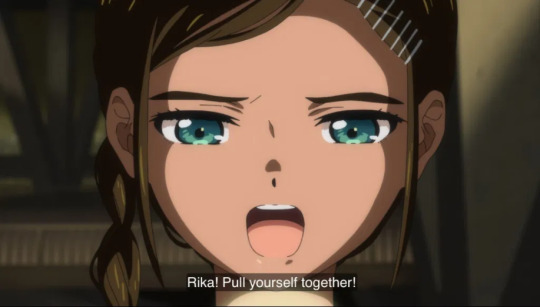
And experiencing that love from a different angle, Rika is changed just a bit. She begins to see her weakness as a “mother,” failing her turtle-child, and thinks of her own mom who is overwhelmed by hurt and a failure as well. And if just a little—for as the final scenes indicate, it is just a little—the path toward forgiveness begins.

But a little bit of grace is like a little bit of a flood—its power overwhelms, and it defeats the enemy, whether that means bitterness, a physical person (or manifestation of one), or the devil himself.
When Rika returns from the event, having killed the cult leader monster, it’s interesting to note that she isn’t a wholly different person. She’s changing little by little. And her scars remain. In fact, as she admits, she probably will cut herself again. But strangely enough, those scars now represent something different. They show someone trying—failing, yes, sometimes considerably and maybe very often—but trying, and only able to try because love was shown her, and through that, she is now able to show love as well.
You may have such scars in your life, physical or emotional, battered by the world and by people. I hope that you can develop relationships that help you heal as well, and that you’ll also remember that there are other scars which are meaningful to you, but which you cannot see on your person, scars that were borne out of a desire to heal you. Christ took the piercings, on his head, hands, feet, and side, so that while your heart and flesh may be cut, your soul need not be. And through his wounds, you may be healed.
The grace offered through Christ is one that, as he explains about everlasting water at the well to the Samaritan, for now and through eternity. The egg seeks peace forever by dying, but Jesus, unlike the cult leader, died for us so that we may not have to. He took the nails, the cross, and the spear so that we don’t have to inflict pain on ourselves and receive the punishment of our actions against him and others. He is our scar.
That’s grace. That’s the power that it has. And it can reach anyone—even a terrible dad, an alcoholic mom, a tempestuous child, and, and most significantly and personally—you.

If you’re suffering and in pain, maybe self-inflicted, we encourage you to explain such to a parent or trusted adult and ask for help. It’s a difficult first step, but one that will help you begin recovering. And we also advise that you turn to Christ for help—in prayer, community, and scripture. He provides people to us that will aid us in our times of need, as well as himself and the Holy Spirit if we are believers.
Additionally, there’s a scene in this episode where triumphant, Rika concludes that cutting is okay. That’s said in the context of her moving forward bit by bit and forgiving herself for her failures, even the upcoming ones. That’s an important lesson, though we must certainly be careful not to let it be a license to continue cutting with impunity.
Wonder Egg Priority can be streamed through Funimation. Read more of our articles by signing up for our weekly newsletter.
197 notes
·
View notes
Text
Arx
Someone left me a comment on a chapter of Exordium (!!!!), and revisiting it was a lot of fun, so I’m sharing some of it.
From here.
~
Zero gravity firefights on the Citadel were not something Garrus had even really fantasized about when working for C-Sec. Yet it was now something he could officially check off his list.
Though, ‘on’ the Citadel was now a mere technicality.
The disorienting part was not so much the distorted sense of space, the abrupt rearrangement of his internal gyroscope, but the soundless recoil of his rifle. The silent sparks erupting from a geth carapace when a slug punched through its shields and scored a critical hit. The open-mouthed roar of a charging krogan that fell upon deaf ears. Visual stimuli painted the inverted battlefield with enough visceral noise to give him a headache, but the muted calm between his ears took some getting used to. Like every turian the military had been part of his life since he turned sixteen, but small arms combat had comprised a rather small part of their all their zero G drills.
The topography of the tower’s outer hide helped a little. Rather than traveling a smooth, unbroken radius all the way to the top, they found themselves confronted by a complicated maze of control junctions, hydraulics, reams of exposed cabling and even keeper access maintenance corridors.
Garrus flashed a somewhat guilty look back at one of the squat green insectoids still tumbling out into the celestial waters behind them.
Up ahead of them, a geth dreadnaught trapped inside the station’s arms prepared to offload troops. Just to make things more fun.
Shepard honed in on a few automated defense turrets that Tali had identified along the Tower’s spine, leading them away from the elevator shaft and deeper into the maze, where they at least had some usable cover. Garrus vaguely remembered some lecture from his C-Sec training about those turrets, but he couldn’t recall a single instance in which they’d ever even been fired. And according to Tali they weren’t firing now. Someone had deactivated them.
Well, not for long. That drop ship wasn’t going anywhere unless they did something about it.
Another round of bullets refracted off his shields, its silent arrival taking nothing away from the teeth-rattling force of impact. Garrus absorbed it with a grunt, praying it wasn’t too much for the emitters to bleed off, and fired off another round of his rifle. Avoiding enemy fire was a lot harder when one wrong step would send you spinning off into space. As the keeper could attest.
At least they were better at keeping their feet on the ground than krogan, who apparently hadn’t all been nuked on Virmire. The only one happy about that development was Wrex, who ignored every single geth trying to shoot a rocket at him in favor of the tank-bred bulldozers racing along the Tower’s exterior.
Turns out that when indoctrinated krogan try to charge a Battlemaster in zero G, the Battlemaster wins. Every time.
The latest one sailed past Garrus’ head, one giant hand flailing in an effort to grab onto the part of Garrus’ helmet that covered his crest. ‘Cresting’ was a traditional krogan method of brutality, an instinct apparently so ingrained by their creator that these half-witted clones didn’t even care there was a helmet in the way. Or that they were currently floating off structure with no hope of recovery.
“Liara!” Alenko called out. “Trooper on your left!”
“I see it,” she called back, and the game the lieutenant and doctor had started playing – levitate the geth high enough for Alenko to kick it out into space – continued. They were getting really good at it.
The terrain around the defense towers consisted of raised bulkheads and sunken trenches to allow safer passage to and from. Shepard laid down cover fire on the latest round of geth while Tali and Alenko ascended the closest one, searching for a control box. The geth drop ship continued to unload some artillery of its own, which only complicated things further.
But that wasn’t what had Garrus’ attention.
The moment they had reached the defense towers, a strange silhouette crested the horizon. Its thick, massive synthetic limbs occasionally rose and fell, their impact against the structure strong enough that Garrus could feel it under his feet even if he couldn’t hear it.
It wasn’t just here. It had anchored itself to the tower itself – its giant maw clamped down on the tower’s peak while the legs maneuvered for purchase.
Spirits. It was huge.
A rocket from one of the destroyers detonated on the other side of the bulkhead Garrus and Shepard now crouched behind. Wrex bellowed – that sound at least traveled over the comm – and charged after it, wrangling the rocket launcher off its back and then firing it point blank into the geth’s chest, which erupted in a hailstorm of silent shrapnel.
“Tali, how’re those turrets coming?” Shepard barked.
“It’s a little hard to concentrate when you’re being fired on by a dropship!”
“We could try launching the angry krogan at it,” Garrus suggested.
“Don’t tempt me.” Shepard rose out of cover to fire his assault rifle. The muzzle blazed with light, the accompanying blare of sound lost out in the vacuum.
Garrus fired his sniper rifle at a destroyer, a maddening lick off the mark. Apparently he relied on the sound of its familiar crack more than he thought to find his rhythm. Here he had to adapt and find it solely through the weapon’s kick. Same beat, different lyrics.
As he reloaded the rifle the destroyer locked its aim on Tali. Garrus’ heart dropped to his feet. He swung the barrel of the gun to keep up, damn those things were fast when they charged, targeting software straining to find a new lock. “Tali, on your three!”
Shepard launched out of cover, rifle firing, pausing only long enough to lob a grenade. It detonated in a shower of sparks. The destroyer turned just as Garrus fired, shot once again glancing off its shields emitters.
“Shepard!”
The destroyer charged, barreling right into Shepard with bone shattering force. The commander spun, his grunt of pain sharp even over the comm, boots losing their grip on the tower.
Garrus fired, this time hitting his mark, slug finding its home right in the orb of the AI’s glowing face. He didn’t take time to gloat, leaping off his perch and flinging a hand out to grab Shepard’s boot.
“Fuck,” Shepard said. The moment his left foot touched down he grimaced and hopped, hissing through his teeth. “That was close.”
“You all right?”
Shepard glanced down at his hardsuit, eyes flicking back and forth as data scrolled across his HUD.
“Fine,” he said after a moment, tone clipped. He tested his weight again, one hand braced against his left hip, and grimaced. Behind them Wrex bellowed and barreled into two troopers trying to flank.
“Shepard?”
“It’s fine.” He swiveled his gaze back toward the turrets. “Got to get those things online and get rid of this dreadnaught.”
As if the turrets listened, they began powering on. Out of the corner of his eyes a bright orange flash accompanied the sudden shudder that swept under his feet. The shields of the dreadnaught glowed bright under the unexpected salvo.
One by one the other turrets came online, four in all, each one painting the geth ship’s hull. Alenko shouted something victorious over the comm. Minutes later Tali dropped in beside Garrus, shotgun back in hand.
“Nice work,” Shepard told her.
The geth ship shuddered, thrusters flashing as it tried to back away from the unexpected threat, then a blaze of light seared Garrus’ retinas as the drive core exploded, raining molten shrapnel down on their heads. Liara threw out her hands, dark energy uncoiling with an electric shimmer, creating a shield around them that deflected the debris. Garrus winced as one flaming piece of metal headed straight for his crest bounced harmlessly off the churning barrier.
“You’re a goddess, Liara,” he called out.
Shepard pushed to his feet and moved out the moment it was clear. His gait stuttered at first, but quickly became fluid and sure. “We need to find a hatch that’ll get us back into the shaft.”
“Preferably in a location that doesn’t involve playing talon touch with the giant reaper,” Garrus replied.
Wrex’s armored head appeared from behind a bulkhead a little farther up, covered in the silken slime of geth conductive fluid. Garrus expected an insult but instead the krogan roared, thundering towards him. Too late Garrus felt a violent strike against his back, followed by the sickening sensation of his feet losing their grip on the ground.
Oh no.
A hand snagged his leg spar, yanking him back down. His boots clamped back down on the deck with a thud. He gasped, then found himself face to face with Wrex’s helmet.
“You missed one,” the krogan growled, gesturing to a downed destroyer now sparking at Wrex’s feet.
“Thanks,” Garrus managed.
“Shepard!” Alenko hollered. “I think I have a way in!”
The commander paused just long enough to catch Garrus’ eye through his faceplate, nodding in satisfaction. “Stick around, Garrus. Things are about to get interesting.”
Garrus risked one last glance up into the incandescent light of the Ward arms, resolutely blocking out the cold curtain of space that lurked outside. A breathtaking view he never wanted to see again.
Yeah. Things were about to get interesting.
#mass effect#garrus vakarian#urdnot wrex#my fic#me legendary countdown#best of swaps mass effect style
30 notes
·
View notes